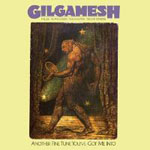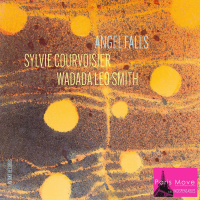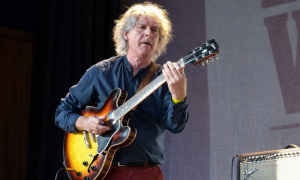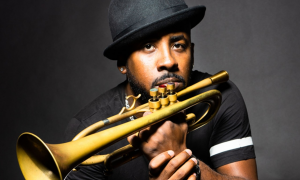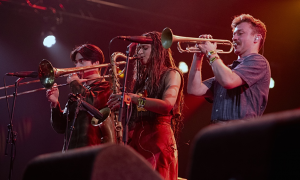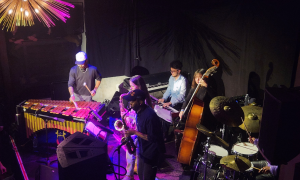Home » Jazz Articles » Live Review » Molde Jazz: Day 4, July 16, 2009
Molde Jazz: Day 4, July 16, 2009
Supersilent / Huntsville
Molde Jazz
Molde, Norway
July 16, 2009
There are those who think that jazz is "moldy fig" music—music for gray hairs and no hairs. There's also some concern that the music will die as the baby boomer generation begins to enter retirement and, ultimately, leave this mortal coil. Nothing could be further from the truth, based not only on the broad demographic that can be seen at all the Molde Jazz performances—ranging from teenagers trying to get into licensed venues like the Alexandra, right through to septuagenarians who could be seen at shows by Supersilent and Huntsville, two highly experimental groups that turned Day 4 of Molde Jazz 2009 into one of its most boundary busting and ear-shattering days of improvised music.

While waiting for Huntsville's late night performance at the Forum, two 20 year-olds talked about how they are collecting music from innovative and forward-thinking labels like Rune Grammofon and Smalltown Supersound/Smalltown Superjazz. When it was suggested that there are those who, in North America, operate under the conception that jazz is an older person's music, they both jumped in before the sentence was finished, saying "No it's not!" Watching both of them become deeply involved in Huntsville's challenging, conventionally inaccessible improvised music—moving to the group's shifting rhythms and excited by its extreme sonics—left little doubt that, in Norway at least, jazz (albeit in the broadest possible definition) is not only alive and well, but thriving. With a large audience of young fans whose ears have been opened through the exposure that they have received, thanks to the country's remarkable arts funding/support, the beauty is that these same people find as much to appreciate in the music of Jamie Cullum (a closet Rune Grammofon fan, apparently) as they do the more extreme spontaneity of Supersilent.
 Molde Jazz artist in residence Arve Henriksen—a charter member of Supersilent—discussed Norway's acceptance of a broad swath of music in an interview that will appear soon at All About Jazz. Through school tours that expose youngsters to sophisticated music at a very young age, to music programs like that at the world-renowned Trondheim Music Conservatory—where Henriksen studied, graduated and, in due course, taught—aspiring artists are encouraged to follow their own muse. Learn about the history to be certain; but don't let that history define you.
Molde Jazz artist in residence Arve Henriksen—a charter member of Supersilent—discussed Norway's acceptance of a broad swath of music in an interview that will appear soon at All About Jazz. Through school tours that expose youngsters to sophisticated music at a very young age, to music programs like that at the world-renowned Trondheim Music Conservatory—where Henriksen studied, graduated and, in due course, taught—aspiring artists are encouraged to follow their own muse. Learn about the history to be certain; but don't let that history define you.Festivals like Molde Jazz, now nearing its 50th anniversary, are proof that cultural education works, in particular in its support of Norwegian artists, with Henriksen's appointment as 2009 artist in residence. While he was only slightly susceptible to the allure of being able to play with international musicians of great stature, ultimately Henriksen chose to work with the artists in Norway with whom he's collaborated for many years (though not always in predictable combinations), because that's the music that's close to his heart and represents what he's attempting to achieve. Based on the first four days of his residency, it was the best possible choice.
Chapter Index
Supersilent
Losing a key band member can be a debilitating or even completely destructive experience—just look at how the death of drummer John Bonham forced Led Zeppelin to dissolve. In the case of Supersilent, the loss of co-founder, drummer Jarle Vespestad (also well-known for his more consistently subtle work with pianist Tord Gustavsen) may have been a significant one, but its Kulturhusett performance made clear that continuing on without him was not only possible, it was inevitable.
 l:r Ståle Storløkken, Arve Henriksen, Helge Sten
l:r Ståle Storløkken, Arve Henriksen, Helge StenStill, while losing the drummer of a group known for genre-busting, ear-shattering and fearlessly futuristic music might seem like a major blow, the reality is that Henriksen—in addition to playing a variety of horns, expertly manipulating electronics to expand any group's soundscape, and singing with a voice that can be, at times, as pure as a choirboy's and at others as world-weary as an older man—also plays drums, and plays them well. His trumpet, electronics and voice were a key part of Supersilent's performance, but he also played a lot of drums throughout a set that consisted of three without-a-safety-net creations: the group's 15-minute opener, the 40-minute primary segment, and a 10-minute encore.
Supersilent's brand of noise improv doesn't shy away from beauty, with the set opening on Henriksen's trumpet alone, delivering a melody of almost painful melancholy. Still, it wasn't long before keyboardist Ståle Storløkken was injecting a variety of oblique lines, jagged chords and otherworldly electronic effects; the control of his rig all the more remarkable for his ability to shift colors on a dime and hyper-energetically generate gradually intensifying sound sculptures.
But the member of Supersilent who truly pushed the group in its direction from the beginning—when he joined up with the other three who were members of an imaginative but slightly more conventional trio called Veslefrekk (formed after Henriksen, Storløkken and Vespestad met at the Trondheim Conservatory)—was Helge Sten, aka Deathprod. As a producer, engineer and sonic manipulator, Deathprod has been instrumental in shaping much of the Rune Grammofon label's direction. As a performer Sten has taken Supersilent into some very dark, harsh and dangerous places, with a combination of wildly overdriven guitar, science fiction-inflected synth and organ sounds. Wild processing created such wildly aggressive and high volume landscapes as to make earplugs essential when situated close to the stage...and even they weren't always enough to block the relentless aural assault of Supersilent at its most extreme.
As cathartic as Sten's contributions were, he was the most physically static performer, at most rocking gently back and forth to the music's pulse, occasionally reacting subtly to its painful power, and often acting as the group's director, providing the occasional subtle cue for shifts in feel, texture or intensity. Storløkken was the most kinetic of the three, hyperactively moving between his three keyboards and host of effects. As co-founder of the Tony Williams/Joe Zawinul-influenced Elephant9, responsible for the outstanding debut Dodovoodoo (Rune Grammofon, 2008), the keyboardist channels music that may possess its own edge, but with Supersilent he's far more unfettered; leaping between keyboards from note-to-note, creating distorted electric piano chords that became increasingly angular and dissonant, working hand-in-glove with Sten's high octane sonics and Henriksen's turbulent and seemingly unschooled drumming.

As free as the music was, there were markers on which the audience could hang its collective hat. The second, lengthy improv gradually evolved to a plodding, backbeat-driven piece of near-anthemic indie rock, supported by Sten's power chords and Storløkken's throbbing bass synth, though that only lasted a short while before the music turned more gentle again—at least for Supersilent—as Henriksen returned to trumpet, sampling himself and creating a processed, harmonized loop over which he group began, once more, to build towards one of its many climaxes.
As with so many of the groups Henriksen is involved in, Supersilent has no concept of delineated roles. Color, pulse, melody and harmony—as dense and near-unapproachable as they sometimes got—were all concepts to be passed around the trio, with no single player ever solely responsible for any of them. Henriksen's drumming was often textural, with Storløkken holding down what groove there was, while Sten delivered alien phrases with tremendous intent. The mix provided a rare opportunity to at least delineate, to some extent, each member's contribution to the overall soundscapes—a wonderful thing since on albums like the potent yet profound 8 (Rune Grammofon, 2007), it's nearly impossible to know who is doing what. Still, that's always been part of the Supersilent mystique; and even watching the group perform, it was not always possible to identify where everything was coming from—something made even more of a challenge, considering the sheer amount of sound often emanating from the stage.
While the group built to a particularly heavy peak during an encore partially driven by the sample of a train rolling down the tracks and building to a final assault of deafening, concentrated sound, Supersilent was also capable of delivering passages of moving beauty that reached down into the collective subconscious. With more elements of sound than could ever be tracked, the group's first performance as a trio made it clear that while there's an undeniable impact felt by Vespestad's departure, it is still more than capable of moving forward, with a new set of priorities dictated by the remaining members finding new ways to deliver what Vespestad did during his 10 and more years with the band.
Huntsville
While capable of similar intensity, Norwegian improvising unit Huntsville has always been less heavy than Supersilent, with its music a unique confluence of unfettered free play, trance-inducing repetition and an uncanny ability to evolve the music so imperceptibly that it's difficult to pin down just how and when shifts have been made. Both the trio's performance at Punkt 2007 and its most recent release, the double-disc Echoes, Arches & Eras (Rune Grammofon, 2009), were strong representations of a group for whom improvisation is at its core. With instrumentation including a tabla machine, acoustic guitar and banjo, Huntsville has integrated elements of folk and Indian music into its aesthetic.
 l:r: Ingar Zach, Tony Kluften
l:r: Ingar Zach, Tony KluftenBut there were some considerable distinctions as well, and some clear changes in the wind. For one, bassist Tony Kluften was playing an electric bass rather than the acoustic one he used at Punkt only two years ago. While he lost certain options—the ability to slide up and down the bass with smooth glissandi, for example—he gained others: bending notes, towards the end of the trio's single, continuous, 70-minute improvised set, with an almost unprecedented elasticity. Less an anchor than a low-register soundscapist, he also integrated a variety of effects to create a sound that, rather than being visceral and in-the-gut, was more atmospheric.
Percussionist Ingar Zach's rig was an unusual one, combining a huge marching band bass drum laid flat on its stand, a couple of snare drums and cymbals, and a variety of machines, including the tabla machine, that drove the shifting pulses throughout most of the performance. He also had an endless array of small sound generators including electric devices that spun and, when placed in a metal bowl on top of the bass drum, created all kinds of surprising textures. Rather than hammering hard, as Henriksen often did with Supersilent, Zach often relied on brushes to create forward motion, even as Kluften's bass fleshed out the bottom end and guitarist Iver Grydeland used a huge floorboard of pedals to turn his electric guitar and banjo into instruments capable of generating sharp, angular lines, gritty dissonant chords strummed with fiery relentlessness, and abstruse chords that created an unsettled foundation for the rest of his band mates.
 Grydeland's approach seemed heavily influenced by Nels Cline—who guested on disc two of Echoes, recorded live at the 2007 Kongsberg Jazz Festival—though he doesn't possess the American guitarist's encyclopedic breadth or penchant for using kitchen implements like a whisk to produce unexpected sounds. But curiously—especially given Echoes' recent release and a quantum leap in its assimilation of Americana roots music into Huntsville's brand of spontaneous invention—Grydeland stayed largely away from anything remotely folkloric; choosing, instead, to mine single notes, like a low open string, for all they were worth, applying an ever-shifting combination of effects and an often frenetic right hand.
Grydeland's approach seemed heavily influenced by Nels Cline—who guested on disc two of Echoes, recorded live at the 2007 Kongsberg Jazz Festival—though he doesn't possess the American guitarist's encyclopedic breadth or penchant for using kitchen implements like a whisk to produce unexpected sounds. But curiously—especially given Echoes' recent release and a quantum leap in its assimilation of Americana roots music into Huntsville's brand of spontaneous invention—Grydeland stayed largely away from anything remotely folkloric; choosing, instead, to mine single notes, like a low open string, for all they were worth, applying an ever-shifting combination of effects and an often frenetic right hand.As unscripted as a Huntsville performance largely is, it's rarely without a pulse, largely from Zach's persistent use of the tabla machine, but equally coming from Grydeland's real-time playing and looping. And that makes it a free experience unusual for the possibility to see the audience swaying slightly with the rhythm, no matter how outré the rest of the proceedings had become. The music ebbed and flowed, with rhythmic emphasis shifting in ways that, if attention wasn't being paid, seemed to come out of nowhere but, in reality, were logical and inevitable outgrowths of what had come before. Less beautiful and more foreboding than some of Supersilent's softer moments, Huntsville's possessed its own charm and, in spite of a clear veneer that was often not for the faint-at-heart, a certain skewed accessibility that kept its audience enthralled for its entire performance.
Tomorrow: Leonard Cohen.
Visit Arve Henriksen, Supersilent, Huntsville and Molde Jazz on the web.
Photo Credits
All Photos: John Kelman
Day 1 | Day 2 | Day 3 | Day 4 | Day 5 | Day 6
Tags
Molde Jazz
Live Reviews
John Kelman
Supersilent
Huntsville
Jamie Cullum
Arve Henriksen
Tord Gustavsen
Nels Cline
PREVIOUS / NEXT
Support All About Jazz
 All About Jazz has been a pillar of jazz since 1995, championing it as an art form and, more importantly, supporting the musicians who make it. Our enduring commitment has made "AAJ" one of the most culturally important websites of its kind, read by hundreds of thousands of fans, musicians and industry figures every month.
All About Jazz has been a pillar of jazz since 1995, championing it as an art form and, more importantly, supporting the musicians who make it. Our enduring commitment has made "AAJ" one of the most culturally important websites of its kind, read by hundreds of thousands of fans, musicians and industry figures every month.


